Ways to Use A.I. to Improve Your Email Copy
Using ChatGPT to write better email messages can enhance your communication efficiency, clarity, and creativity. Here are some practical ways you can leverage ChatGPT to improve your email writing:
1. Crafting Compelling Subject Lines
- Challenge: Writing subject lines that grab attention and improve open rates.
- How ChatGPT Can Help: Ask ChatGPT to generate multiple subject line options based on the purpose of your email. You can specify the tone (professional, casual, urgent, etc.) and context.
- Example Prompt: “Generate 5 catchy and professional subject lines for a promotional email offering a 20% discount on our new product line.”
2. Improving Email Tone and Style
- Challenge: Ensuring the right tone for your audience (formal, friendly, casual, etc.).
- How ChatGPT Can Help: Provide ChatGPT with the context of the email and ask for variations in tone. For example, you might need to write a formal thank-you email or a casual follow-up message.
- Example Prompt: “Rewrite this email in a more friendly and conversational tone, while still keeping it professional.”
3. Writing Persuasive or Sales Emails
- Challenge: Writing emails that drive action or conversions (e.g., sales, sign-ups).
- How ChatGPT Can Help: ChatGPT can help structure persuasive emails by suggesting hooks, benefits, and clear calls-to-action. You can ask for specific tactics like urgency, social proof, or highlighting pain points.
- Example Prompt: “Write a persuasive email promoting our new software with a clear call-to-action to schedule a demo. The tone should be professional but compelling.”
4. Creating Follow-Up Emails
- Challenge: Writing polite, engaging follow-up emails without being too pushy.
- How ChatGPT Can Help: Ask ChatGPT to draft gentle reminders or follow-up emails with a focus on being polite and respectful while still prompting action.
- Example Prompt: “Write a friendly follow-up email to a client who hasn’t responded to my previous message about scheduling a meeting.”
5. Improving Email Clarity and Conciseness
- Challenge: Ensuring your emails are clear, to the point, and easy to understand.
- How ChatGPT Can Help: You can paste your email drafts into ChatGPT and ask for suggestions on making it more concise or clear. ChatGPT can help remove jargon, redundant phrases, and ensure a smooth flow.
- Example Prompt: “Can you rewrite this email in a more concise and clear way? Remove any unnecessary details and make the message direct.”
6. Generating Email Templates
- Challenge: Saving time on routine emails.
- How ChatGPT Can Help: Use ChatGPT to generate templates for common email types, such as welcome emails, thank-you emails, or onboarding messages. This way, you’ll have a solid structure that you can personalize for each case.
- Example Prompt: “Create a professional thank-you email template for a client after they’ve made a purchase.”
7. Personalizing Emails at Scale
- Challenge: Personalizing emails for a large group while maintaining a genuine tone.
- How ChatGPT Can Help: ChatGPT can help you craft a template with placeholders for personalization, like names, company names, or specific interests. It can even assist with creating different variations to keep the content engaging.
- Example Prompt: “Generate a personalized email template for a product recommendation based on a customer’s past purchases. Include a special offer for them.”
8. Enhancing Grammar and Language
- Challenge: Ensuring your email is grammatically correct and error-free.
- How ChatGPT Can Help: If you’re unsure about grammar, structure, or style, you can ask ChatGPT to proofread your email, suggest corrections, or provide rewording alternatives.
- Example Prompt: “Please proofread this email and suggest improvements for grammar, structure, and readability.”
9. Writing Customer Service Emails
- Challenge: Addressing customer queries or complaints effectively while maintaining a professional tone.
- How ChatGPT Can Help: ChatGPT can help you craft empathetic, solutions-focused responses. You can specify the situation and tone, such as how to address a delayed order or an angry customer.
- Example Prompt: “Write an empathetic response to a customer who is frustrated because their order was delayed. Offer a solution and an apology.”
10. Generating Email for Internal Communication
- Challenge: Writing clear, informative, and actionable internal emails.
- How ChatGPT Can Help: You can use ChatGPT to generate emails for team updates, project briefings, or meeting invitations. This can help ensure clarity and reduce misunderstandings.
- Example Prompt: “Write a professional email to my team outlining the steps they need to follow for the upcoming product launch.”
11. Creating Email Segments and Campaigns
- Challenge: Developing different email variations for segmented audiences.
- How ChatGPT Can Help: ChatGPT can help you create targeted email messages tailored to different audience segments (e.g., new subscribers, VIP customers, lapsed buyers).
- Example Prompt: “Write three variations of an email campaign for a product launch: one for new subscribers, one for loyal customers, and one for people who haven’t bought in six months.”
12. Generating Email Greetings and Sign-Offs
- Challenge: Finding the right way to start and end your emails.
- How ChatGPT Can Help: ChatGPT can suggest appropriate greetings and sign-offs based on the formality and relationship with the recipient.
- Example Prompt: “Provide 5 professional email opening lines for a business partner and 5 friendly sign-offs for a close colleague.”
By utilizing ChatGPT in these ways, you can streamline your email writing process, improve your communication, and save time while ensuring high-quality, effective emails.







Comments